Fauna

Peacock Pansy Junonia almana
The adult butterfly has a wingspan of 54–62 mm (2.1–2.4 in),[1] and exhibits seasonal polyphenism. Dry-season form "Upperside rich orange-yellow. Fore wing with a pale dusky and a much darker short transverse bar with lateral jet-black marginal lines across cell, another somewhat similar bar defining the discocellulars; costal margin, an inner and an outer subterminal line, and a terminal line dusky black; a large minutely white-centred ocellus with an inner slender and outer black ring on disc in interspace 2; two similar but smaller geminate subapical ocelli with an obscure pale spot above them and a short oblique bar connecting them to the black on the costa. Hind wing: a small minutely white-centred and very slenderly black-ringed discal ocellus in interspace 2, with a very much larger pale yellow and black-ringed ocellus above it spreading over interspaces 4, 5 and 6, the centre of this ocellus inwardly brownish orange, outwardly bluish black, with two minute white spots in vertical order between the two colours; finally postdiscal subterminal and terminal black sinuous lines.[1] "Underside ochraceous brown, very variable. In most specimens the cell of the fore wing is crossed by three dark sinuous bands, the outermost along the discocellulars; these are very faint in some; both fore and hind wings crossed by a basal and a discal pale sinuous line, the latter margined outwardly by a dark shade, which is traversed by an obscure somewhat obsolescent row of dark spots, and outwardly bounded by a subterminal sinuous line, the dark shade in many cases spreading on the fore wing to the terminal edge of the wing; on the hind wing the subterminal line meets the discal in an acute angle at the tornus. Antennae dark brown; head, thorax and abdomen more or less orange-brown; paler beneath.
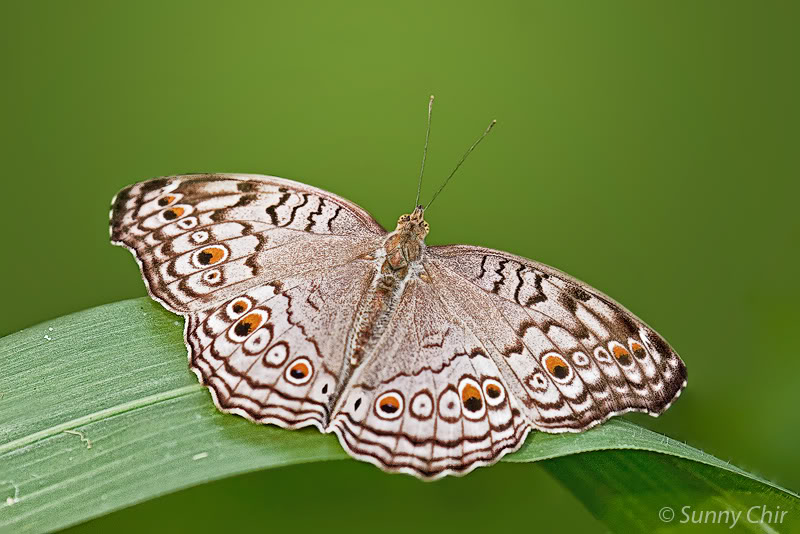
Grey Pansy (Junonia atlites)
Upperside of both sexes pale lavender brown, apical half of wings paler. Forewing: cell with, three transverse, short, sinuous black bands, the outermost defining the discocellulars; a similar short, somewhat broader band beyond the apex of the cell; two transverse discal dusky black fasciae, the inner highly sinuous and outward, angulate above vein 4, the outer straighter, somewhat lunular, bordered by a series of whitish ovals with dusky or black centers. The black-centered spots in the ovals in interspaces 2, 5, and 6 margined posteriorly with rich ocherous yellow. Beyond this series of ovals is a lunular, narrow, transverse dark band, followed by sinuous subterminal and terminal broad dark lines. Apex of wing slightly fuliginous. Hindwing: a short slender black loop from veins 6 to 4 at apex of cell-area; two discal sinuous transverse dark, fasciae in continuation of those on the forewing: followed by a series of dark-centered ovals in interspaces 2–6, the ovals in interspaces 2, 5, and 6 with the dark centers inwardly broadly bordered with ochreous yellow; postdiscal, subterminal and terminal dark lunular lines as on the forewing. Underside lilacine white markings as on the upperside but very delicate, slender and somewhat obsolescent. In the dry-season forms of the males the rows of oval ocelli are only indicated by the yellow-centered ovals. The most prominent marking is the inner discal fascia crossing the wings; this is much less sinuous than on the upperside and not angulated on the forewing. In the females the markings are all heavier and more distinct, the space between the various transverse fasciae tinged with ocherous.
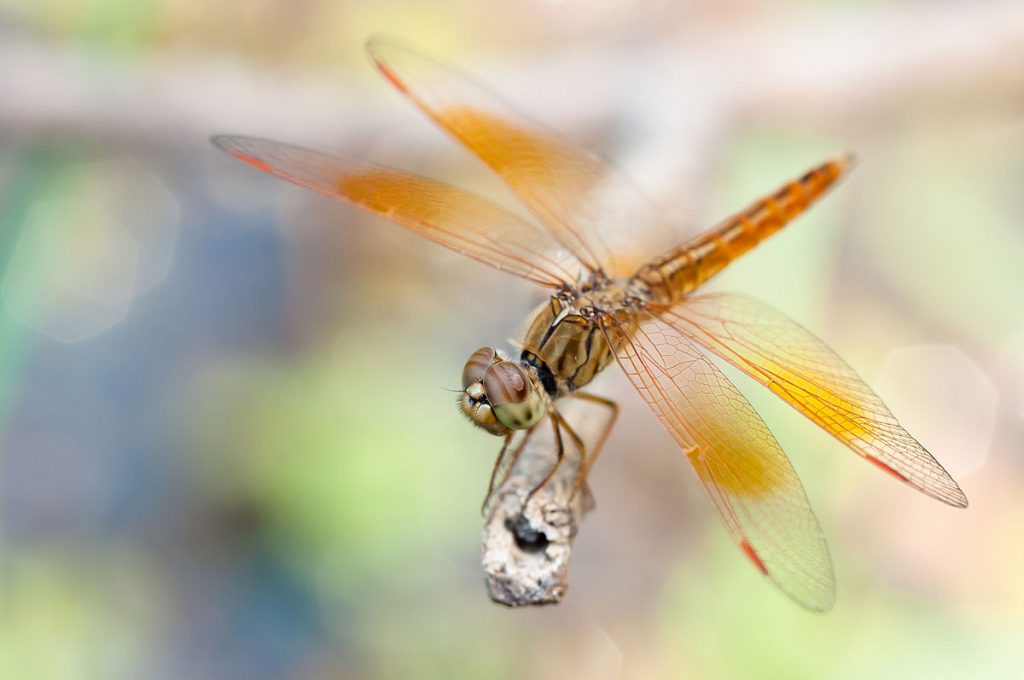
Ditch Jewel (Brachythemis Contaminata)
It is a small dragonfly with brown-capped yellowish-green eyes. Its thorax is olivaceous-brown, marked with a reddish-brown humeral stripe and two brownish stripes on each side. Wings are transparent; but with a broad bright orange fascia extending from base to within 2 to 3 cells of reddish pterostigma. Abdomen is ochreous-red, marked with dorsal and sub-dorsal brown stripes. Anal appendages are in reddish-brown. Female is similar to the male; but in pale yellowish-green color. Wings are transparent, tinted with yellow at extreme base;, but the bright orange fascia seen in the male absent.[7] It breeds in weedy ponds, lakes, and slowly moving streams; especially in sluggish waters. It is very common along sewage canals, tanks, ponds and ditches.

Baronet Euthalia nais
The male and the female both have tawny-yellow uppersides. The forewing has a traverse black line below apex cell and an oval spot beyond encircling a small yellow spot, a broad short oblique discal bar and an angulated postdiscal lunular band the costa narrowly and the termen shaded with black. Hindwing: a comparatively large triangular patch below the middle of the costa, a postdiscal evenly curved series of spots and a broad band along the termen black. Underside dark ochraceous red. Forewing: the base shaded with fuscous black, two spots at base of cell and a transverse line beyond crimson pink, edged with black: a very broad oblique discal band, angulated downwards below vein 4, bordered posteriorly by a large black spot on the inner side and outwardly and anteriorly by an oblique broad black band, followed by four anterior obliquely placed ochraceous-white spots, and beyond by a very narrow lunular black band bent downwards below vein 6. Hindwing: a crimson short line at extreme base, two crimson black-bordered spots in cell: a comparatively broad transverse discal white band often broken up into a large spot below middle of costa, with two or three spots in line below it; finally, a postdiscal series of small black spots. Antennae are black, bright ochraceous at apex; head, thorax and abdomen tawny red above, brown shaded with crimson-pink below.
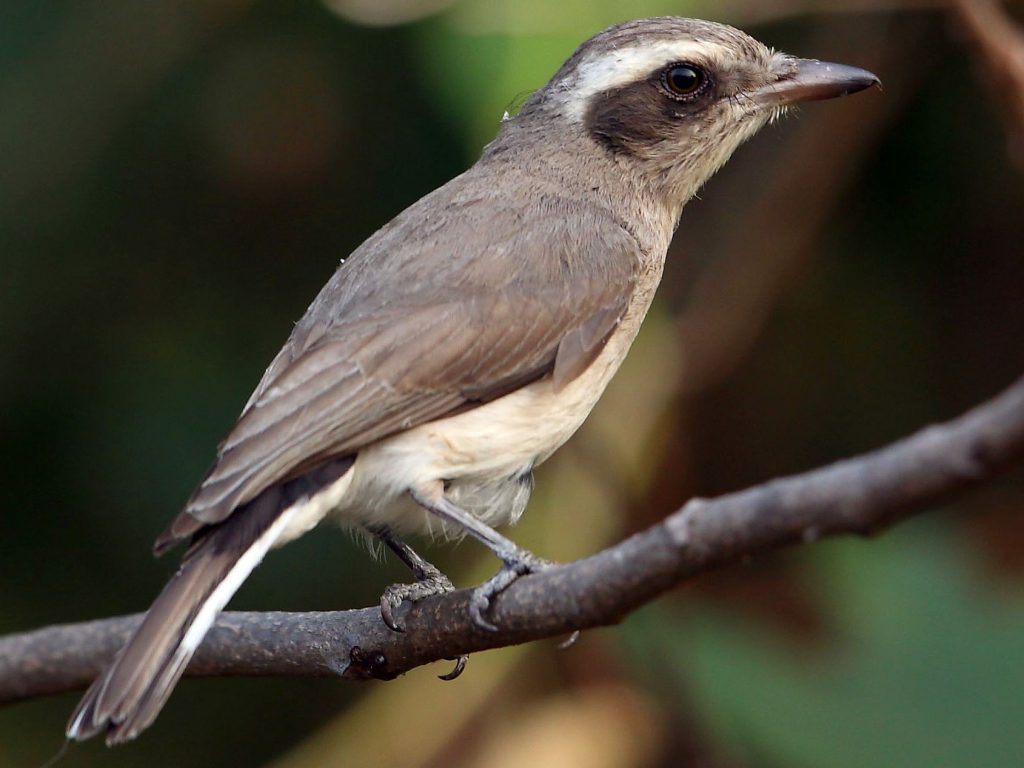
Common Woodshrike (Tephrodornis pondicerianus)
The common woodshrike is dully ashy brown and like other woodshrikes has a large head with a strong hooked beak. They have a broad creamy brow above a dark cheek patch and white outer tail feathers contrasting with their dark tail. Young birds have streaks and spot on the crown and white spots on the mantle. The underside is also streaked and the breast is heavily marked in young birds. The Sri Lankan species is similar darker on the underside, with the dark cheek bordered below by a buffy sub-moustachial stripe and a white rump
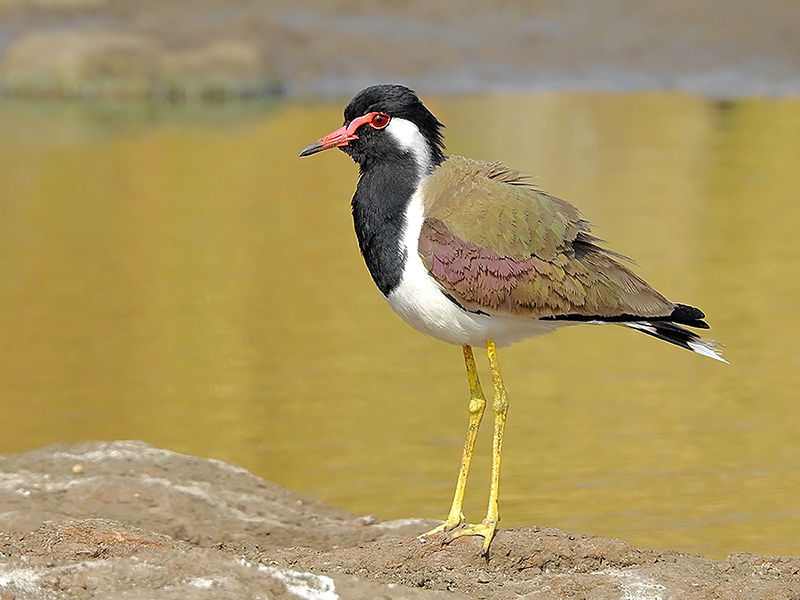
Red-wattled Lapwing Vanellus indicus
Red-wattled lapwings are large waders, about 35 cm (14 in) long. The wings and back are light brown with a purple to green sheen, but the head, a bib on the front and back of the neck are black. Prominently white patch runs between these two colours, from belly and tail, flanking the neck to the sides of crown. Short tail is tipped black. A red fleshy wattle in front of each eye, black-tipped red bill, and the long legs are yellow. In flight, prominent white wing bars formed by the white on the secondary coverts. Race aigneri is slightly paler and larger than the nominate race and is found in Turkey, Iran, Iraq, Afghanistan and the Indus valley. The nominate race is found all over India. The Sri Lankan race lankae is smaller and dark while atronuchalis the race in north-eastern India and eastern Bangladesh has a white cheek surrounded by black. Males and females are similar in plumage but males have a 5% longer wing and tend to have a longer carpal spur. The length of the birds is 320–350 mm, wing of 208–247 mm with the nominate averaging 223 mm, Sri Lanka 217 mm. The Bill is 31–36 mm and tarsus of 70–83 mm. Tail length is 104–128 mm. It usually keeps in pairs or trios in well-watered open country, ploughed fields, grazing land, and margins and dry beds of tanks and puddles. They occasionally form large flocks, ranging from 26 to 200 birds.[15] It is also found in forest clearings around rain-filled depressions. It runs about in short spurts and dips forward obliquely (with unflexed legs) to pick up food in a typical plover manner.They are said to feed at night being especially active around the full moon. Is uncannily and ceaselessly vigilant, day or night, and is the first to detect intrusions and raise an alarm, and was therefore considered a nuisance by hunters. Flight rather slow, with deliberate flaps, but capable of remarkable agility when defending nest or being hunted by a hawk. Its striking appearance is supplemented by its noisy nature, with a loud and scolding did-he-do-it call, uttered both in the day and night. Leucistic abnormal plumages have been noted. The local names are mainly onomatopoeic in origin and include titeeri (Hindi), titawi (Marathi), tittibha (Kannada), tateehar (Sindhi), titodi (Gujarati), hatatut (Kashmiri), balighora (Assamese), yennappa chitawa (Telugu),aal-kaati (Tamil, meaning "human indicator")
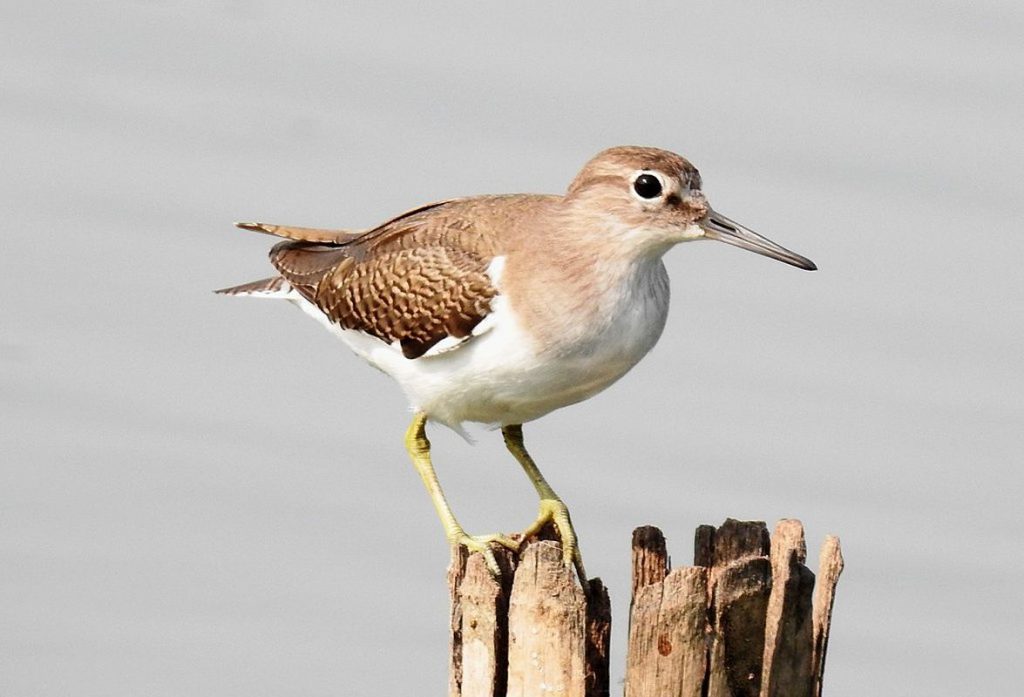
Common Sandpiper Actitis hypoleucos
The adult is 18–20 cm (7.1–7.9 in) long with a 32–35 cm (13–14 in) wingspan. It has greyish-brown upperparts, white underparts, short dark-yellowish legs and feet, and a bill with a pale base and dark tip. In winter plumage, they are duller and have more conspicuous barring on the wings, though this is still only visible at close range. Juveniles are more heavily barred above and have buff edges to the wing feathers.[4] This species is very similar to the slightly larger spotted sandpiper (A. macularia) in non-breeding plumage. But its darker legs and feet and the crisper wing pattern (visible in flight) tend to give it away, and of course they are only rarely found in the same location.
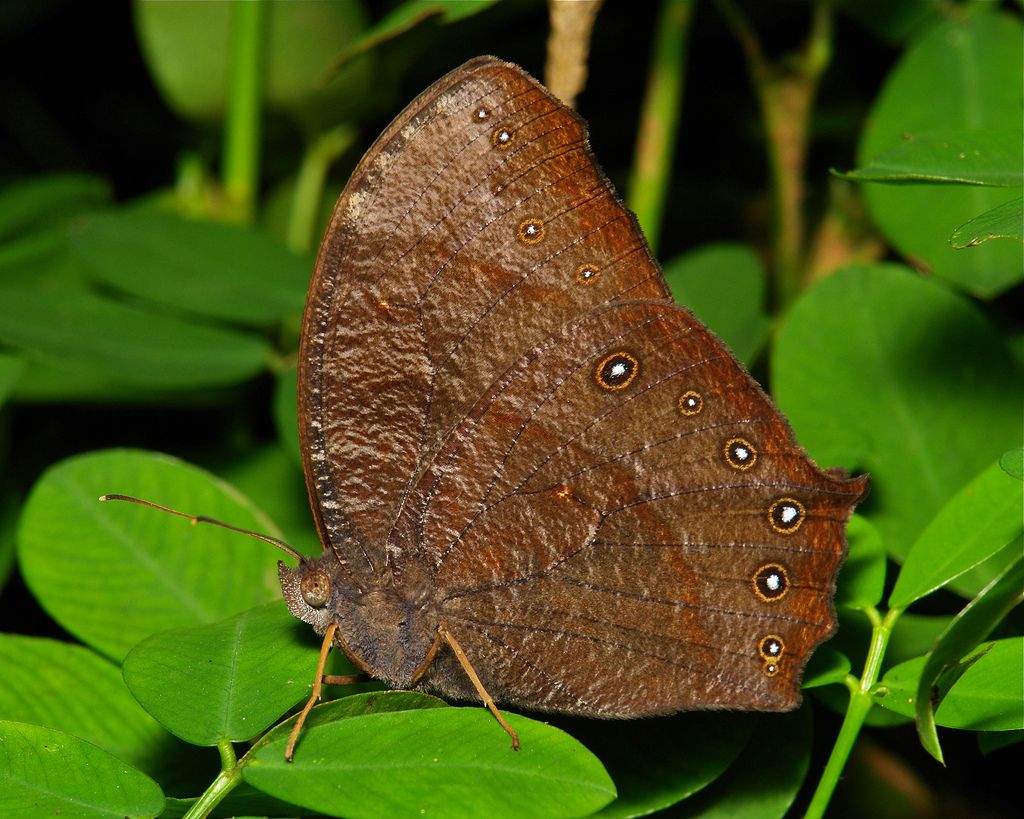
Dark Evening Brown
Wet-season form: Male. Upperside dusky fuliginous-brown, the outer borders palest; cilia brown. Forewing very slightly angled below the apex; with a well-defined subcostal nearly round ochreous patch before the apex, divided by the brown radial veinlets. Hindwing unmarked. Underside dark purpurescent-brown, densely and uniformly covered with ochreous-cinereous strigae; the outer border ferruginous. Forewing with four ordinary small obscure white-pupilled ocelli. Hindwing with a series of six submarginal prominent ocelli, the upper second minute, the anal geminated, the other four nearly equal and much larger, each pupilled with white. Female. Upperside. Both wings much paler than in the male. Forewing more broadly angled below the apex; with the entire apical area broadly pale ochreous, on which is placed a round black spot with white pupil, situated between the upper and middle median veinlets, also a minute obsolescent ocellus below it and three above it. Hindwing with a small posterior submarginal black spot between the middle aud lower medians, pupilled with white. Underside. Both wings with the ground colour pale purpurescent ochreous, densely covered with darker brown strigae, the basal area and outer borders of the discal fascia slightly washed with pale purpurescent-cinereous; the ocelli as in the male, but rather larger; the outer margins ochreous. Forewing with an obscure ochreous oblique medial and a waved discal narrow fascia, and the hindwing with a medial excurved similar fascia, the two latter somewhat most defined. Body beneath, and palpi cinereous-ochreous speckled; legs brown; antennae brown, with a pale ochreous tip. Dry-season form: Male. Upperside much deeper dusky-brown than in the wet-season form, the colour having a purpurescent tint, and the outer borders are thickly speckled with purpurescent-cinereous scales, Forewing with a more acute and prolonged angle below the apex than in male of the wet-season form; the large apical patch being of a rich ochreous and darkest inwardly, the patch extending from within the end of the cell to the cinereous marginal border; the ocelloid spots being obscurely defined. Hindwing unmarked; the tail much prolonged. Underside very densely purpnrescent-brown or purpurescent olive-brown, the cinerescent strigae very irregular and more or less indistinctly disposed and mottled, the basal area darkest, the outer discal washed with cinereous; the ocelloid spots smaller, very ill-defined. Female. Upperside much paler than in the male, with less distinct cinereous margins. Forewing even more acutely angled below the apex than in male; the rich ochreous apical patch occupying about half the wing, extending more or less well into the cell and to the posterior angle, the enclosed ocelloid spots being present as in the female of the wet-season form, or the two ordinary-disposed subapical black spots are developed, but both well-separated, more or less elongated, and with a distinct white pupil. Eindioing with one, or two, posterior submarginal white dots. Underside. Both wings dusky ochreous, with uniformly-disposed dark brown strigae, which are sometimes more or less irregularly blotched; the submarginal ocelloid spots also blotched.
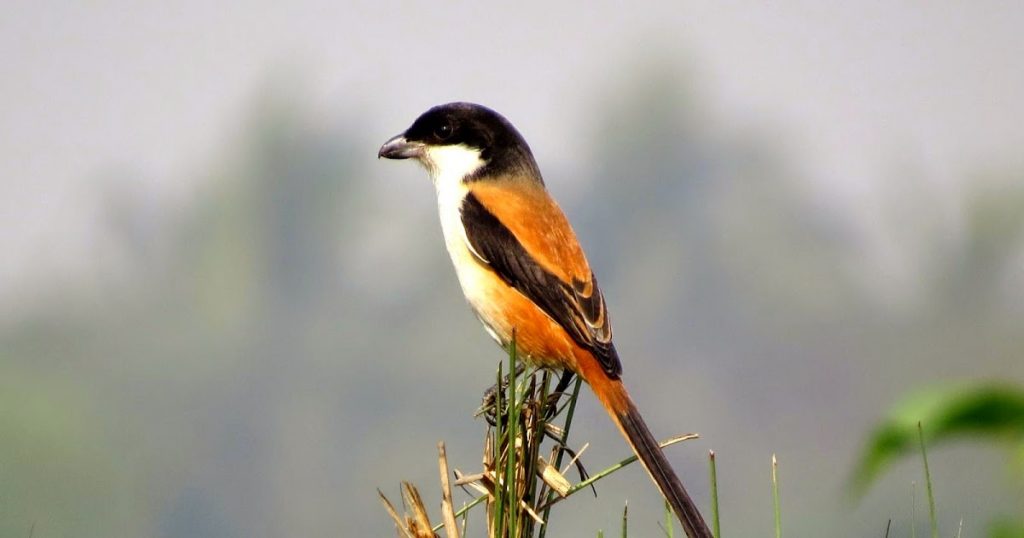
Long-tailed Shrike Lanius schach
The long-tailed shrike is a typical shrike, favouring dry open habitats and found perched prominently atop a bush or on a wire. The dark mask through the eye is broad and covers the forehead in most subspecies and the whole head is black in subspecies tricolor and nasutus. The tail is narrow and graduated with pale rufous on the outer feathers. Subspecies erythronotus has the grey of the mantle and upper back suffused with rufous while the southern Indian caniceps has pure grey. A small amount of white is present at the base of the primaries. The bay-backed shrike is smaller and more contrastingly patterned and has a more prominent white patch on the wing. The sexes are alike in plumage.

Chalky Percher Diplacodes trivialis
Diplacodes trivialis is small dragonfly with bluish eyes and greenish-yellow or olivaceous thorax and abdomen with black marks. In very old adults, the whole thorax and abdomen become uniform pruinosed blue. Clear wings, without apical or basal markings, and the creamy white anal appendages and deep pruinescence in adults help to distinguish this species from others in its genus. It breeds in ponds, wet rice fields, shallow lakes, drainage ditches and similar habitats. It is one of the most common dragonflies in Asia, found in both the plains and hills and in dry and wet areas.

Indian Nuthatch Sitta castanea
The Indian nuthatch (Sitta castanea) is a species of bird in the family Sittidae. It is found in Bangladesh, India and Nepal. Its natural habitats are subtropical or tropical dry forests, subtropical or tropical moist lowland forests, and subtropical or tropical moist montane forests. This species has been split by Rasmussen and Anderton (2005) from the chestnut-bellied nuthatch. The Indian nuthatch (including the older prateri of the Eastern Ghats) is found South of the Ganges river. It is the only grey-backed, rufous-bellied nuthatch in the peninsula. Similar to the next but has a smaller bill and a frosty crown that is paler than the mantle. The wing and tail patterns lack contrast and has grey centres to the chestnut undertail coverts. Resident in the Terai and Gangetic plain extending into Central India, the Eastern Ghats, Sunderbans and a disjunct population in the Western Ghats. Breeds from February to July. Different in vocalization from the next.
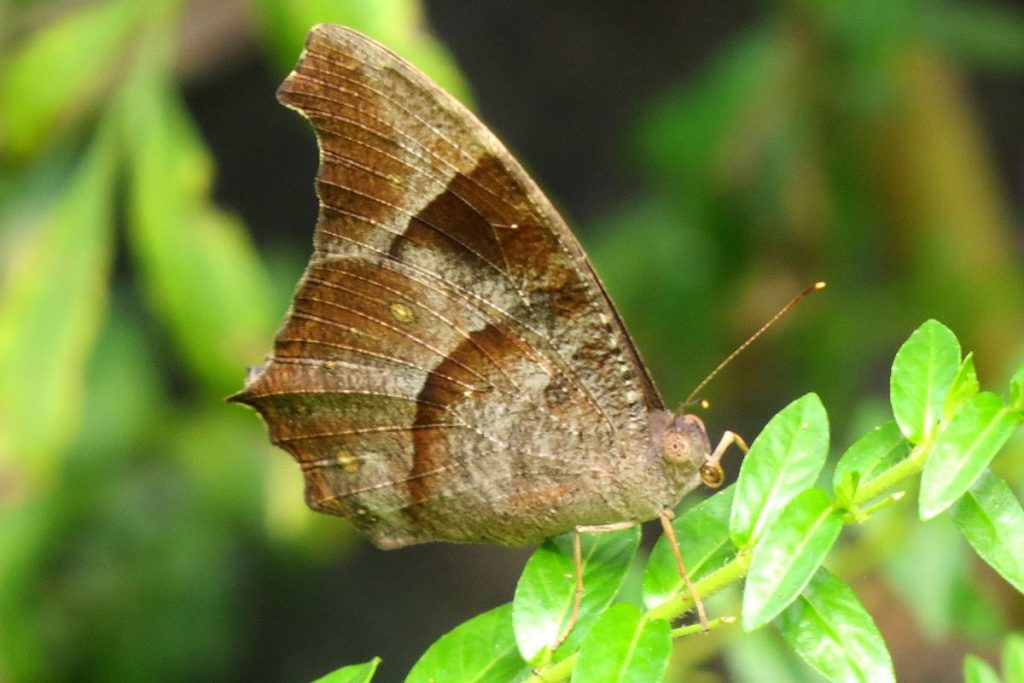
Great Evening Brown Melanitis zitenius
Wet-season form. Male and female: Forewing: costa strongly arched, apex acute; termen immediately below apex in male angulate, in female falcate (sickle shaped). Upperside resembles M. ismene, but ground colour on the whole somewhat warmer brown, a very broad patch of ochraceous yellow, above and beyond the subapical black spots, larger in the female than in the male. Underside closely irrorated (sprinkled) with dark brown striae (lines); the ocelli subequal, very much smaller and less clearly defined than in M. ismene. Dry-season form. Costa of forewing less strongly arched; apex in both sexes very falcate. From the wet-season form it differs in the greater amount of ochraceous yellow on the apex of forewing. This forms a very broad band passing from the costa above and beyond the subapical black spots, spreading below and encircling them except for a narrow band which joins the spots to a large black mark beyond apex of cell. Hindwing with two or three white subterminal spots posteriorly. Underside as in M. ismene but not quite so variable, the ocelli often entirely obsolete.
Flora
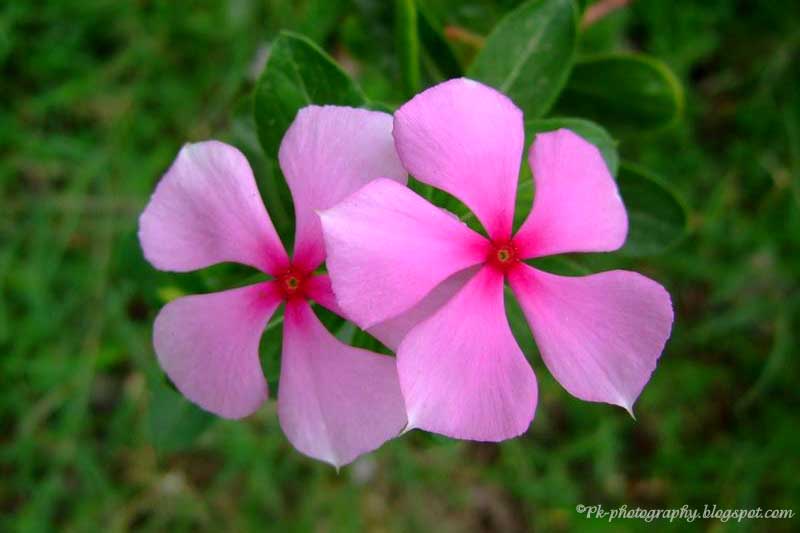
Madagascar Periwinkle Catharanthus roseus
Catharanthus roseus is an evergreen subshrub or herbaceous plant growing 1 m (39 in) tall. The leaves are oval to oblong, 2.5–9 cm (1.0–3.5 in) long and 1–3.5 cm (0.4–1.4 in) broad, glossy green, hairless, with a pale midrib and a short petiole 1–1.8 cm (0.4–0.7 in) long; they are arranged in opposite pairs. The flowers are white to dark pink with a darker red centre, with a basal tube 2.5–3 cm (1.0–1.2 in) long and a corolla 2–5 cm (0.8–2.0 in) diameter with five petal-like lobes. The fruit is a pair of follicles 2–4 cm (0.8–1.6 in) long and 3 mm (0.1 in) broad.
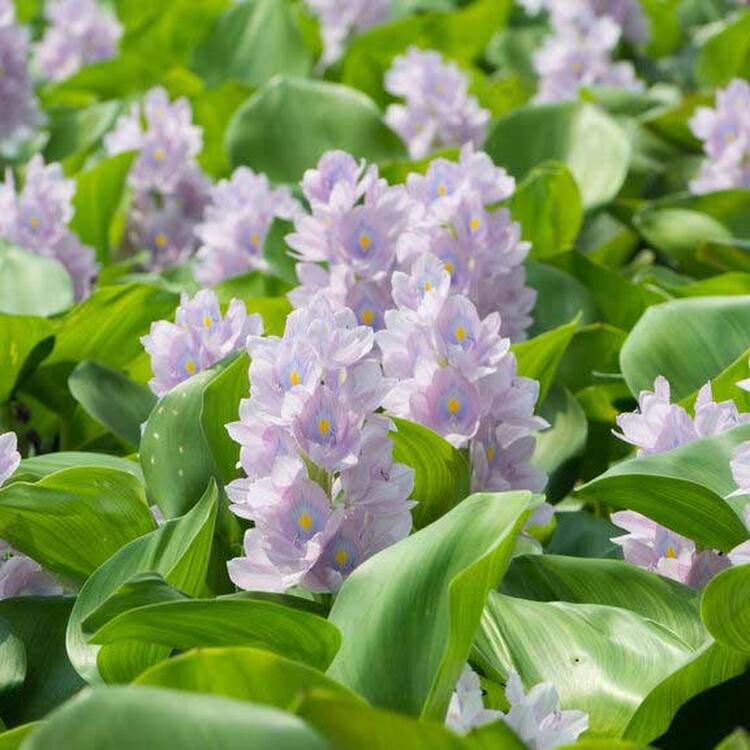
Great Evening Brown Melanitis zitenius
Water hyacinth is a free-floating perennial aquatic plant (or hydrophyte) native to tropical and sub-tropical South America. With broad, thick, glossy, ovate leaves, water hyacinth may rise above the surface of the water as much as 1 meter (3 feet) in height. The leaves are 10–20 cm (4–8 inches) across on a stem which is floating by means of buoyant bulb-like nodules at its base above the water surface. They have long, spongy and bulbous stalks. The feathery, freely hanging roots are purple-black. An erect stalk supports a single spike of 8–15 conspicuously attractive flowers, mostly lavender to pink in colour with six petals. When not in bloom, water hyacinth may be mistaken for frog's-bit (Limnobium spongia) or Amazon frogbit (Limnobium laevigatum). One of the fastest-growing plants known, water hyacinth reproduces primarily by way of runners or stolons, which eventually form daughter plants. Each plant additionally can produce thousands of seeds each year, and these seeds can remain viable for more than 28 years. Some water hyacinths were found to grow between 2 and 5 meters (7 and 16 feet) a day in some sites in Southeast Asia. The common water hyacinth (Pontederia crassipes) are vigorous growers and mats can double in size in one to two weeks. And in terms of plant count rather than size, they are said to multiply by more than a hundredfold in number, in a matter of 23 days. In their native range, these flowers are pollinated by long-tongued bees and they can reproduce both sexually and clonally. The invasiveness of the hyacinth is related to its ability to clone itself and large patches are likely to all be part of the same genetic form. Water hyacinth has three flower morphs and is termed "tristylous". The flower morphs are named for the length of their pistil: long, medium and short. Tristylous populations are however limited to the native lowland South America range of water hyacinth; in the introduced range, the M-morph prevails, with the L-morph occurring occasionally and the S-morph is absent altogether.This geographical distribution of the floral morphs indicates that founder events have played a prominent role in the species' worldwide spread.
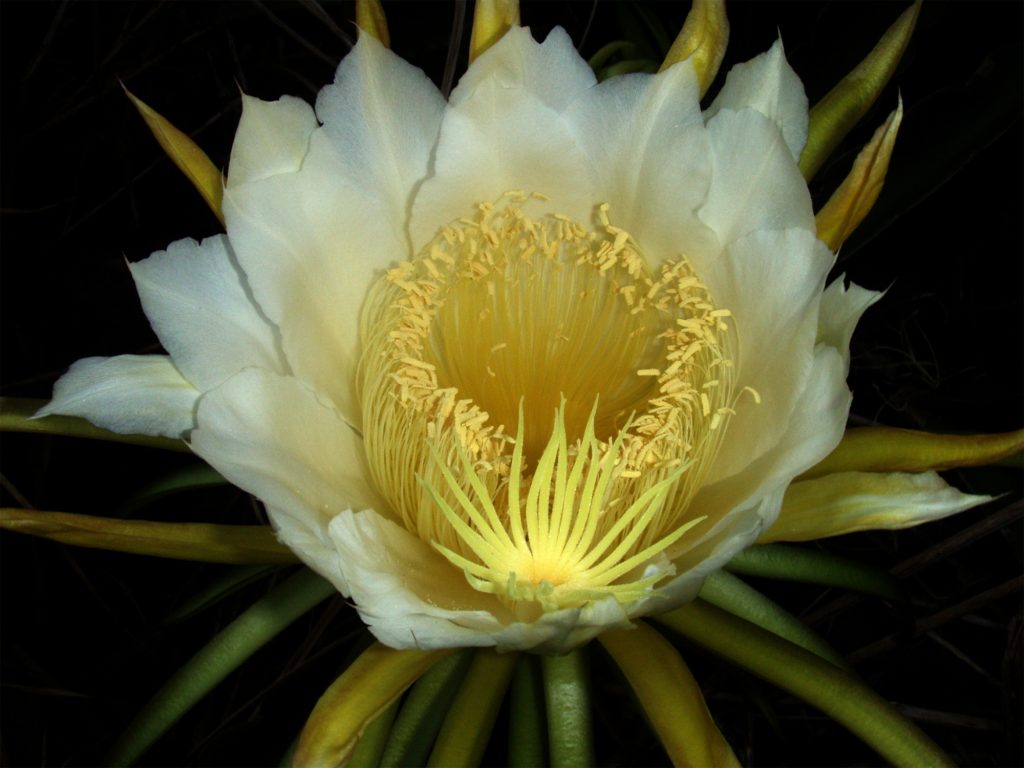
Night-blooming Cereus Selenicereus undatus
Dragonfruit stems are scandent (climbing habit), creeping, sprawling or clambering, and branch profusely. There can be 4–7 of them, between 5 and 10 m or longer, with joints from 30–120 cm or longer, and 10–12 cm thick; with generally three ribs; margins are corneous (horn-like) with age, and undulate. Areoles, that is, the small area bearing spines or hairs on a cactus, are 2 mm across with internodes 1–4 cm. Spines on the adult branches are 1–4 mm long, being acicular (needle-like) to almost conical, and grayish brown to black in colour and spreading, with a deep green epidermis. The scented, nocturnal flowers are 25–30 cm long, 15–17 cm wide with the pericarpel 2.5–5 cm long, about 2.5 cm thick, bracteoles ovate, acute, to 2.5 to less than 4 cm long; receptacle about 3 cm thick, bracteoles are linear-lanceolate, 3–8 cm long; outer tepals lanceolate-linear to linear, acuminate (tapering to a point), being 10–15 cm long, 10–15 mm wide and mucronate (ending in a short sharp point). Their colour is greenish-yellow or whitish, rarely rose-tinged; inner tepals are lanceolate (tapering to a point at the tip) to oblanceolate (i.e. more pointed at the base), up to 10–15 cm long about 40 mm wide at widest point, and mucronate, unbroken, sharp to acuminate (pointed), and white. Stamens 5–10 cm long, are declinate, inserted in one continuous zone from throat to 35 mm above the pericarpel and cream. The style (bearing the stigma) to 17, they are 5–24.5 cm long, stout, 6–8 mm thick, cream, and up to 26 stigma lobes, they can be whole or sometimes split at the top, cream, about 25 mm long. Nectar chambers are 30 mm long. The fruit is oblong to oval, 6–12 cm long, 4–9 cm thick, red with large bracteoles, with white pulp and edible black seeds.

